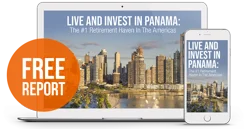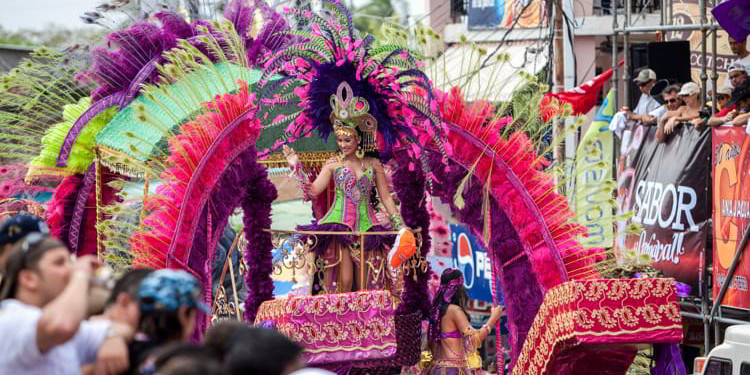Carnaval is the biggest party of the year in Panama and businesses shut down for nearly a week.
Celebrations take place across the country, but Chitré and Las Tablas have two of the most famous carnavales.
The festival is similar in purpose to Mardi Gras in New Orleans—a time for indulgence and revelry before the Catholic period of Lent (a time of solemnity and sacrifice) begins on Ash Wednesday. But the similarities end there.
Carnaval takes place during the four days leading up to Ash Wednesday, beginning on Friday and ending on Tuesday.
Each town’s Calle Arriba (uptown) and Calle Abajo (downtown) battle for carnaval supremacy. Both appoint queens who sit atop parade floats dressed in striking feather-laden costumes and lacy, handmade polleras.
Calle Arriba and Calle Abajo take turns parading the streets of town with three parade vehicles. The first is for the princesses—young ladies with dreams of becoming future queens, with equally elaborate getups. The queen follows on the second parade float, and a float with a murga, or brass band, trails third.
Aside from parades, there are the famous culecos—street dances involving cistern trucks that spray crowds with water while music blares from speakers—nonstop parties, fireworks, folkloric traditions, and, of course, food and drink (if you’re not familiar with Seco, Panama’s national liquor, this might be a good time to start working up your tolerance).
Carnaval is the event of the year in Panama, and it’s attended by Panamanians and foreigners of all ages… from children to grandparents.
This year’s carnaval began on Friday and wraps up tonight.
I asked LIOS staff in Panama to share some carnaval dos and don’ts…
Marketing Manager Abby Perez says:
“Don’t travel to the interior on the Friday before carnaval… you’ll be stuck in traffic for twice as long as on a regular heavy traffic day. It’s much better to leave on the Wednesday or Thursday before carnaval.
“The same goes for driving back to the city. Don’t return on Tuesday or Wednesday and instead opt for the Thursday after carnaval.
“This isn’t a good time to head to the beach. They’ll be so crowded that it’ll be impossible to relax and enjoy. There’s loud music and kids playing pranks.
“If you won’t be partaking in the carnaval festivities, stay in Panama City (if that’s where you live). It’s the best time to enjoy a quiet, clean, nice, relaxing weekend with no traffic, no noise, and no crowds.
“Things to do in the city that you can’t do on a regular weekend?…
“Take a walk on the Cinta Costera without being run over by cyclists and children. Same goes for Amador Causeway—you can rent a bike and go for a chill ride, no people on the sidewalks at all. Go out to your favorite restaurants and get special treatment for being one of the only people there.
“If you want to experience the cultural side of carnaval without the parties and crowds, the best time is during early January when there are desfiles de reinas (queens’ parades). The most famous one is in Las Tablas. Not many people go and it’s very familiar and authentic. Less party-get-wild type of thing.”
Web Developer Carlos Barahona recommends going to carnaval at night…
“Carnaval at night is amazing… it’s a completely different scene than carnaval during the day. At night there are murgas (brass bands), people dancing and having a good time, and you can actually move through the streets—it’s really fun. During the day you’re better off finding something else to do unless you’re into heavy partying.
“Don’t go to culecos—the water is dirty, everyone is drunk, it’s impossible to move because of the thousands of people crowded together, there are sometimes fights, and you’re likely to have something stolen.”
Get Your Free Panama Report Today!
Simply enter your email address below and we'll send you our FREE REPORT - Live And Invest In Panama: The #1 Retirement Haven In The Americas.
Business Office Manager Iranovy Grenald says:
“The most popular places to celebrate carnaval are Las Tablas, Chitré, and Ocú (this little town in known for its water parades). Here are my recommendations for staying safe and healthy during carnaval…
“Stay hydrated—keep a water bottle with you at all times. Wear sunscreen, a hat, and sunglasses. Take only what you need and leave valuables and credit cards at home. Use a money belt to hide your cash and keys.
“If you’re going to the parades, take a chair and umbrella with you for comfort. If you’re carrying a backpack, wear it on the front of your body so you don’t get pick pocketed. Keep your I.D. with you and have a copy of your passport on hand or a picture of it on your phone. It’s better to go to the parades and activities with people you know for safety. Avoid any interactions with drunk people and never drink and drive. It’s better to not drive at all because there will be drunk drivers.
“I’m not a fan of carnaval, so I take advantage of the free days to travel abroad or to an island in Panama like Isla Grande or Bocas del Toro.
“If you’re like me and don’t enjoy crowds or rowdy people, you could head to the paradisiacal beaches of the small fishing village Pedasí or relax in the mountains in Boquete, El Valle, Altos de Santa Maria, or Altos de Campana.”
Graphic Designer Candice Gonzalez tells me:
“Carnaval is about culecos, which can get crowded, messy, and uncomfortable. They aren’t for everyone.
“The best culecos are in Las Tablas. Try to arrive before 9 a.m. so you can find a spot before it gets extremely crowded.
“If you go at night, you can still see the parade floats and it won’t be as crowded.
“PH-pub Herrerano is a traveling outdoor event venue that’s present in most towns where carnaval is held during the days of the celebration. It’s basically an outdoor club and is one of the best places to have a good time. There are plenty of other venues as well, such as Xzone.
“Keep up with the music and learn the popular songs—you might discover some new favorites.
“Avoid carnaval celebrations in Panama City. They’re dangerous and you won’t get the true carnaval experience.
“If you want to see the best parade floats, wildest culecos, and the most elaborately dressed queens, go to Las Tablas.”
Marketing Assistant Maria Arias shares her personal carnaval traditions:
“I adore the culecos in my hometown Las Tablas. I enjoy the colorful street parades, fireworks, costumes, and, of course, parties.
“But just one day is more than enough for me. The other days I love to relax at Playa Venao, a beach about an hour from Las Tablas.”
Marketing Assistant Alberto Acosta says:
“Carnaval is the perfect excuse to have fun in all possible ways. Some people enjoy the parties, others prefer the tunas (when rival groups compete by singing back and forth to the rhythm of tamborito, Panamanian folkloric music)and the more traditional and cultural aspects of carnaval, while others’ favorite part is the culecos because of the refreshing water and the rhythm of the murgas.
“Wherever you plan to be (at carnaval, in the mountains, at the beach, or somewhere else), the only requirement is to have fun.”
Gabrielle Wells
Editor, Panama Letter










